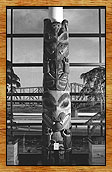 
(Page 2 of 2) |
Tanu
James G. Swan visited Tanu in 1883, just five years after Dawson. He was accompanied by Chief Gitkun's son Kitkune, who volunteered to show him his father's great house:
He entered it by knocking off one of the massive planks, crawled inside and unfastened the door so that Swan's party could bring their cargo kit inside . . . The place was of huge proportions, fifty feet long and with walls eight inches thick. Young Kitkune opened a hidden door and revealed a chamber where sacred emblems of the old chief were kept. The owner was reluctant to part with many and then only for a large price.
Swan notes in his diary: "I would have been willing to pass several days at Laskeek [Tanu] as there is more of interest there than at any village I have seen." He wanted to experience as much as possible and persuaded Kitkune to show him more: "Young Kitkune took Swan to an uncle's tomb, a small structure behind the big house. The sepulchre contained an elaborately carved box, two guns, ammunition boxes, and the carved stick the dead man had held when distributing presents at potlatches."

 |
This interior house pole from Easy to Enter House at Tanu was carved by the artist known as "the Master of the Chicago Settee," according to Bill Holm. The pole belonged to the chief's wife and displays the Sea Grizzly Bear crests of her father, the chief of Skedans.
Photograph by Charles F. Newcombe, 1901. |

For the Columbian World Exposition in Chicago in 1893, Swan collected an exceptional interior central pole about 5 m (16 feet) high, which stood in Easy to Enter House. The crests on it belong to the chief's wife, who claimed rights to the crests of the chief of Skedans village. After the fair, the pole was deposited in the Field Museum, which sold the pole but kept a unique talking stick (shaped like a narwhal tusk inlaid with abalone shell) that was attached to it. The pole went through several private owners before it was purchased by the Canadian Museum of Civilization. The Field Museum kindly restored the talking stick to the pole, where it now protrudes prominently from the forehead of the lowest of two Wasgo (or Sea Wolf) figures. The myth associated with this pole is that of the Wasgo, who lived in the lake behind Skidegate village and had the ability to transform between the form of a Wolf and a Killer Whale. The pole shows the Wasgo in two states, with and without his Whale attributes. According to Bill Holm, the pole was carved by the unnamed artist whom he has dubbed "the Master of the Chicago Settee." Several of the house frontal poles collected by Swan for the passed through various owners until they were eventually acquired by the Canadian Museum of Civilization.
At the time of Swan's visit, only fifteen people were living at Tanu. The mortuary columns outnumbered the totem poles and houses of the inhabitants.

 |
The same interior house pole from Easy to Enter House in Tanu as shown above, restored and on display in the Grand Hall of the Canadian Museum of Civilization. The narwhal tusk talking stick, which was separated from the pole for a number of years, has been replaced in its original position.
CMC VII-B-1797a (pole), CMC VII-B-1797b (talking stick) |

|